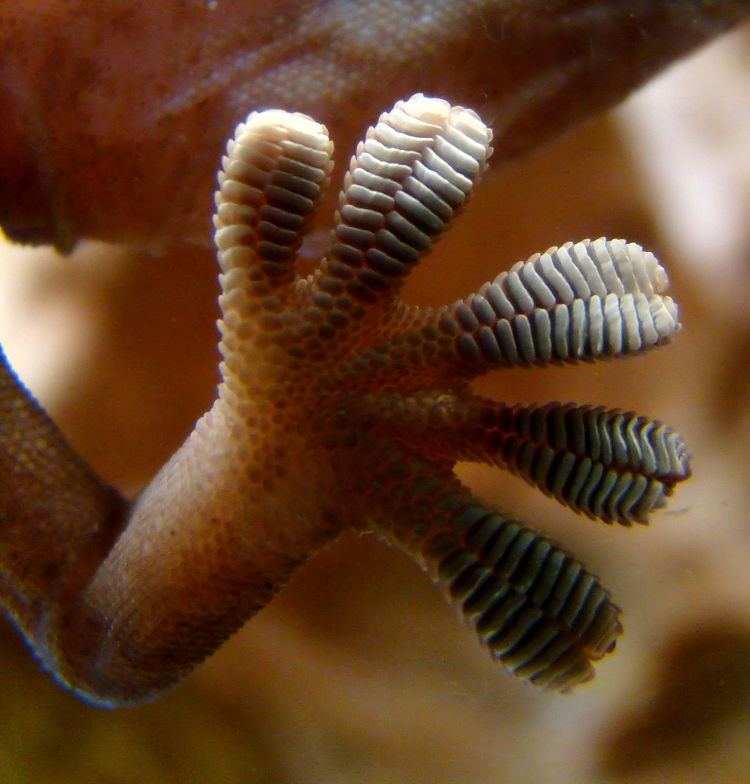 | ||
The feet of geckos have a number of specializations. Their surfaces can adhere to any type of material with the exception of Teflon (PTFE). This phenomenon can be explained with three elements:
Contents
- Background
- Chemical structure
- Physical structure
- Hamaker surface interaction
- Factors affecting adhesion
- Van der Waals interaction
- Modeling seta potential
- Experimental verification
- Synthetic adhesives
- References
Background
Geckos are members of the family Gekkonidae. They are reptiles that inhabit temperate and tropical regions. There are over 1,000 different species of geckos. They can be a variety of colors. Geckos are carnivorous, feeding on insects and worms. Most gecko species, including the crested gecko (Rhacodactylus ciliatus), can climb walls and other surfaces.
Chemical structure
The interactions between the gecko's feet and the climbing surface are stronger than simple surface area effects. On its feet, the gecko has many microscopic hairs, or setae (singular seta), that increase the Van der Waals forces between its feet and the surface. These setae are fibrous structural proteins that protrude from the epidermis, which is made of β-keratin, the basic building block of human skin.
Physical structure
The β-keratin bristles are approximately 5 μm in diameter. The end of each seta consists of approximately 1,000 spatulae that are shaped like an isoceles triangle. The spatulae are approximately 200 nm on one side and 10–30 nm on the other two sides. The setae are aligned parallel to each other but not oriented normal to the toes. When the setae contact another surface, their load is supported by both lateral and vertical components. The lateral load component is limited by the peeling of the spatulae, and the vertical load component is limited by shear force.
Hamaker surface interaction
The following equation can be used to quantitatively characterize the Van der Waals forces, by approximating the interaction as being between two flat surfaces:
where F is the force of interaction, AH is the Hamaker constant, and D is the distance between the two surfaces. Gecko setae are much more complicated than a flat surface, for each foot has roughly 14,001 setae that each have about 1,000 spatulae. These surface interactions help to smooth out the surface roughness of the wall, which helps improve the gecko to wall surface interaction.
Factors affecting adhesion
Many factors affect adhesion, including:
Van der Waals interaction
Using the combined dipole–dipole interaction potential between molecules A and B:
where WAB is the potential energy between the molecules (in joules), CAB is the combined interaction parameter between the molecules (in J m6), and D is the distance between the molecules [in meters]. The potential energy of one molecule at a perpendicular distance D from the planar surface of an infinitely extending material can then be approximated as:
where D′ is the distance between molecule A and an infinitesimal volume of material B, and ρB is the molecular density of material B (in molecules/m3). This integral can then be written in cylindrical coordinates with x being the perpendicular distance measured from the surface of B to the infinitesimal volume, and r being the parallel distance:
Modeling seta potential
The gecko–wall interaction can be analyzed by approximating the gecko seta as a long cylinder with radius rs. Then the interaction between a single seta and a surface is:
where D′ is the distance between the surface of B and an infinitesimal volume of material A and ρA is the molecular density of material A (in molecules/m3). Using cylindrical coordinates once again, we can find the potential between the gecko seta and the material B then to be:
where AH is the Hamaker constant for the materials A and B.
The Van der Waals force per seta, Fs can then be calculated by differentiating with respect to D and we obtain:
We can then rearrange this equation to obtain rs as a function of AH:
where a typical interatomic distance of 1.7 Å was used for solids in contact and a Fs of 40 µN was used as per a study by Autumn et al.
Experimental verification
The equation for rs can then be used with calculated Hamaker constants to determine an approximate seta radius. Hamaker constants through both a vacuum and a monolayer of water were used. For those with a monolayer of water, the distance was doubled to account for the water molecules.
These values are similar to the actual radius of the setae on a gecko's foot (approx. 2.5 μm).
Synthetic adhesives
Research attempts to simulate the gecko's adhesive attribute. Projects that have explored the subject include:
